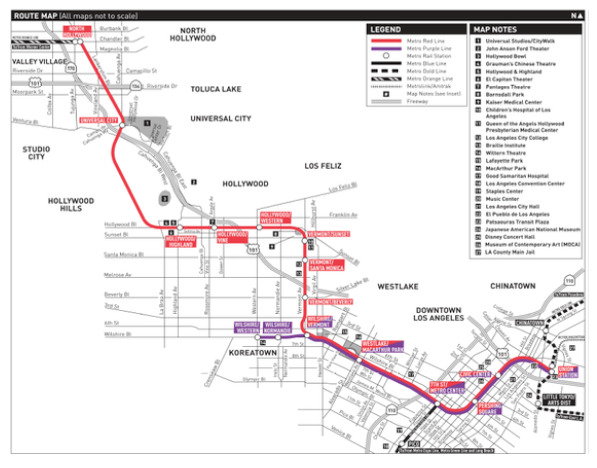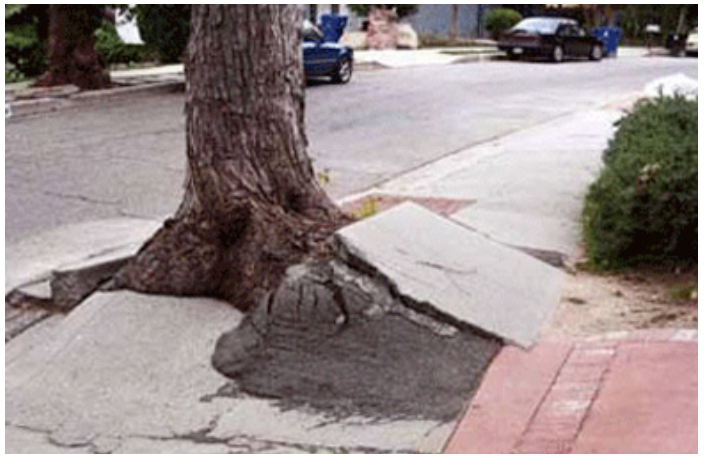CommentsPLATKIN ON PLANNING-Every year I used to look forward to Esquire’s Dubious Achievement awards, and since the magazine has revived these awards, I have two nominees.
The first is METRO, for its design and construction of the Purple Line Extension subway. The second is the Los Angeles Department of City Planning for its preparation of a “transit neighborhood plan” for the areas surrounding the new Purple Line subway stations at Wilshire/LaBrea and Wilshire/Fairfax.
First Nomination: METRO. At $700 million per mile before cost overruns, METRO’s nomination for a Dubious Achievement Award is based on the long list of features that they have neglected to include at the new Purple Line subway stations:
- Similar to existing METRO subway and light rail stations, toilets, newspaper racks, vending machines, kiosks, retail stores, and restaurants are not included in the new bare-bones stations.
- Parking lots, known as Park ’n Ride facilities, are also nowhere to be found, except for existing and mostly occupied museum parking lots at the Wilshire/Fairfax station.
- Bicycle/scooter lanes and parking areas, as well as Metro Bike Share stations, are also missing. Even though transit riders would be prime candidates to hop on short-term rental bikes, and then peddle to a nearby station close to their house or apartment, METRO has no plans to place any bike sharing stations in the Purple Line Extension area.
- Interfaces for busses, cars, taxis, Ubers, and Lyfts to let off and pick up passengers are standard subway station features, but not for the Purple Line Extension subway stations.
- METRO already has many local and express bus lines operating in the Purple Line Extension area, but none will garner such transit-friendly upgrades as bus shelters, reduced fares, posted schedules, signage, shorter headways, and real time phone apps. The transit dependent, who comprise the bulk of bus passengers, again get the short end of the stick.
While these omissions appear to be stupefyingly stupid for an agency spending billions to extend an existing subway line, at least the new stations will be similar to the austere Red and Purple Line subway stations opened 22 years ago.

Second Nomination: LA City Planning. As impressive as these omissions are for an LA-based Dubious Achievement Award, I think the under-appreciated labors of the Department of City Planning’s preparation of the Purple Line Extension ‘transit neighborhood plan” (TNP) may impress discerning CityWatchLA readers even more.
- Despite its name, the TNP has nothing to do with transit, whether existing bus service or the new subway. All it does is reduce parking requirements and increase the height, size, and density of privately-owned parcels.
- The TNP also has nothing to do with neighborhoods. In fact, City Planning excluded local community groups from its miniscule outreach efforts, instead linking up with real estate lobbyists from outside neighborhoods.
- Likewise, the TNP has no connection to LA’s planning process. The Wilshire Community Plan, which entirely encompasses the TNP, will soon begin its comprehensive update. Yet, the TNP timeline jumps this queue, ensuring that its Specific Plan up-zoning ordinance will be walled off from the Wilshire Community Plan’s update.
- The TNP will undermine LA’s affordable housing programs. At present, to obtain bonuses for reduced parking and greater building height, size, or density, developers must include affordable housing. Under the TNP, developers will be given all of these bonuses up front, without any requirements to include affordable housing in new, pricey apartment buildings.
- The TNP will reduce subway ridership, not increase it, because new housing will be expensive. In fact, based on the recently opened, high-rise apartment building at Crescent Heights and Wilshire, one-bedroom units will rent for $4,500 a month. This guarantees that future tenants will be well off, the precise demographic that owns cars, drives them most of the time, and rarely rides mass transit.
- The TNP ignores local bus service and bus stops. Like METRO, the TNP does not include any improvements to local bus service or bus shelters.
- The TNP ignores bicycle infrastructure, as well, because it does not add any bicycle lanes or bicycle parking to the TNP area and nearby neighborhoods.
- The TNP completely ignores sidewalks and pedestrian issues. No broken and lifted sidewalks will be repaved. No ADA curb cuts will be installed. No intersection bulb-outs are planned. No signage will inform walkers where the subway and other landmarks are located.

- The TNP ignores shade street trees, landscaping, and street furniture, despite City Planning’s two remarkable on-line manuals. At present, there is virtually no landscaping or street furniture in the TNP area, and, barring a stranger riding in on a white horse, this grim, transit-unfriendly reality will continue.
- The TNP leaves plug-ugly billboards, bootlegged commercial signs, and overhead wires in place. If it eliminated these off-putting design features, the entire area would become far more appealing to pedestrians, bicyclists, and bus and subways riders.
- The TNP assumes an imminent population boom for the Wilshire area, but this is pure fiction. Furthermore, if it were to happen, existing zoning, which the City Council substantially increased to implement the Wilshire Community Plan’s 2002 update, can meet all growth scenarios. In fact, the local population could double, and the existing zoning would still have unused capacity.
- The TNP totally ignores the limitations of local infrastructure and services. It is old, poorly maintained, and already failing at existing levels of population and development. If an adopted TNP encouraged the construction of new market rate apartments and offices, they would soon push the area’s public services and infrastructure to the brink.
- In the 1980s, the Department of City Planning prepared sophisticated Specific Plans for the previously proposed subway stations at Wilshire/LaBrea and Wilshire/Fairfax. Instead of removing these completed plans from a file cabinet and quickly updating them, City Hall has already devoted two years to develop alternative plans from scratch.
The competition between these two nominees might be fierce, buy why play favorites? After all, METRO bankrolled LA City Planning’s efforts to prepare and adopt the Purple Line Extension Transit Neighborhood Plan. Even if this up-zoning scheme does not appear on METRO’s many web sites, he who pays the piper picks the “build, baby, build” tune before the next financial crisis.
(Dick Platkin is a former Los Angeles city planner who reports on local planning controversies for CityWatchLA. Please send any comments or corrections to [email protected].) Prepped for CityWatch by Linda Abrams.
















